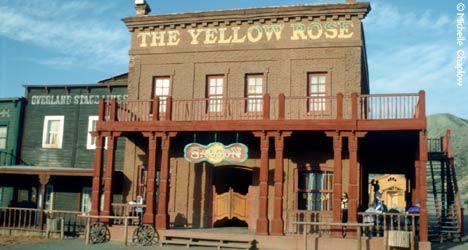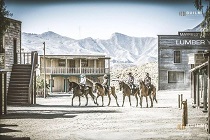
TABERNAS
by Saskia Mier
The landscapes surrounding Tabernas are practically lunar. Its canyons and rocky plains have been used as film sets since the days of Clint Eastwood and the Spaghetti Westerns. More recently, Game of Thrones was filmed in the desert gorges known as the Rambla del Cautivo and La Rambla del Buho near the village. This is where 100 horses and 500 extras formed the long march in Episode 4, in which Daenerys Targaryen leads the Dothraki, the nomadic horse-riding warrior tribe (see the complete Andalucia Game of thrones location listings). Tabernas has about 3,700 inhabitants.
Game of Thrones is an American fantasy drama television series. It is an adaptation of A Song of Ice and Fire, George R. R. Martin's series of novels, the first of which is called A Game of… More →
Sandwiched between the mountains of the Sierra Nevada, Gador, Filabres and Alhamilla is one of the most dramatic landscapes in Spain, the desolate Desierto de Tabernas. The only semi-desert in… More →
The Tourist Office of Tabernas is located in Avenida de las Angustias (Wild West style Saloon building), opening from Monday to Sunday.
The festivals in Tabernas are Cabalgata de Reyes Magos, San Sebastián, Día de Andalucía, Semana Santa, Fiestas de San Marcos, Romería de San Isidro, Fiestas de San Juan and Feria de Tabernas en… More →
It is believed that the village’s name comes from Thabernax, named for the Greek legions, because it was the place where the troops were supplied in many inns or sales. Prehistoric settlements… More →
Situated at Km 474 of the N-340 highway is Route 66, a popular American bar. Its name draws a link between the famous dusty American road and Spain´s iconic coastal route, and sits well amongst… More →
In the 1960s and 1970s more than 100 films were partially shot at these two film sets in the bleak Almeria desert landscape of Tabernas, including Westerns such as A Fistful of Dollars, The… More →
HISTORY
It is believed that the village’s name comes from Thabernax, named for the Greek legions, because it was the place where the troops were supplied in many inns or sales. Prehistoric settlements have been found, such as the town of Terrera Ventura (2850-1950 B.C), a Neolithic agro-pastoral and livestock settlement. More>
THINGS TO SEE
Castillo de Tabernas
The Hispano-Muslim fortress dates from the fourteenth and fifteenth centuries and has a polygonal, elongated plan of almost 3000m2. Situated in an unbeatable strategic position, it closes access to the capital from the main communication route with the eastern peninsula. It has survived until today divided into two enclosures by a wall with a sixteenth-century artillery tower. Today, eight towers remain standing, some of which have been restored, while the wall disappears in some parts of the enclosure. The site was declared an Asset of Cultural Interest in 1985. Located on Camino al Castillo.
Iglesia de Nuestra Señora de la Encarnación
The Church was built in the Mudejar style which dominated the religious architecture of the old Kingdom of Granada. Its construction was carried out during the sixteenth and seventeenth centuries, commissioned by Bishop Antonio Corrionero and concluded in 1610. Its two carved stone façades show the two stages of the construction of the Church and indicate its stylistic evolution. The interior features a remarkable main altar which came from the Parroquia del Corazón de Jesús in Almería, and the altar of the Virgen del Carmen, carved from marble in 1865. The church was declared an Asset of Cultural Interest in 2019. Located on Glorieta de España.
Ermita de San Sebastián
The Chapel was built on a synagogue between the twelfth and fourteenth centuries and later restored during the time of the Catholic Kings and transformed into a temple. Located on Calle San Sebastián.
Ermita de Nuestra Señora de las Angustias
This small Chapel was founded between the eighteenth and nineteenth centuries. It was formerly a cemetery, and long before it may have been a neighborhood Mosque. Today, it is the headquarters of the popular Brotherhood of Angustias. Located on Avenida de las Angustias.
Plaza de Toros
The bullring was built in 1986 using stone and cement, and has a capacity for two thousand people. It is used for bullfights without picadors during the festivities, which can be attended by anyone, since entry to the square is completely free. This is one of the few bullrings that exist in the entire region. Located off Avenida de las Angustias.
Centro de Interpretación Terrera Ventura y Desierto de Tabernas
The Terrera Ventura and Desierto de Tabernas Interpretation Centre was created for visitors to learn about the way of life of this prehistoric culture, its tools and its industry. The visit is completed with an area dedicated exclusively to the Tabernas Desert, unique in Europe, where you can learn about its geological formation, its uniqueness and its similarities with other deserts. Located on Calle Alcazaba.
Opening Times:
By appointment only.
Tel: 950 10 64 01
THINGS TO SEE OUTSIDE THE VILLAGE
Oro del Desierto
An early twentieth century oil mill, with its own museum, showing the evolution of the oil production process through three life-size old mills and various models. It also has a restaurant, Los Albardinales, where the organic oil of the house, as well as other organic and typical products of the region, are the centrepieces of the menu. Located on Carretera Nacional 340.
Oasys Mini Hollywood
Visitors to Oasys Mini Hollywood can enjoy a mock bank hold-up and shootout, staged at noon, 5pm and 8pm daily, and stop off for a cold beer at the Western-style saloon, which stages can-can shows. There is also a pool, a cactus garden and a zoo with 800 animals of 175 species, including giraffes, lions, zebras and buffalo, and parrot demonstrations.
Fort Bravo Entrance Ticket

The sets here are 100% original, found in the natural landscape of the Tabernas Desert. Fort Bravo is still used for film shootings, adverts, and short movies and clips. The studios have an American and a Mexican town, offering visitors a Saloon-Bar, a restaurant, a souvenir shop, and a photo studio to dress up in classical Wild West costume and take a photo as a souvenir; in a frame resembling classic 'Wanted' posters.![]()
Route 66 American Bar
This bar opened as an homage to American popular culture, serving burgers, steaks, kebabs, fries and other familiar American dishes. The bar attracts an 80% Spanish audience, and is busiest on Saturday nights and Sunday afternoons, when rock tribute bands often perform.
Plataforma Solar
After the oil crisis in 1973, solar energy was launched, with first generation solar thermal systems being constructed for energy production in the Tabernas Desert. The Almería Solar Platform, with almost three thousand hours of sunlight and the particular climatic characteristics of Tabernas, has been capable of creating the largest European centre for testing applications in the field of solar thermal energy. The Centre for Environmental and Technological Energy Research and the DLR German Aerospace Research Centre operate here concurrently, developing different research programs at their facilities, such as solar detoxification and distributed control systems. It has a visitor center, consisting of a guided tour, video projection and interactive demonstrations, etc. Located north of the town, off the A-349. Tel: 950 38 78 00.
NATURAL AREAS
Paraje Natural Desierto de Tabernas
The only semi-desert in Europe; there is a surreal, lunar quality to its weirdly eroded ravines, dry river beds and barren slopes apparently devoid of vegetation, bleached by the sun and occasionally singed with ochre hues. With its poor soils, low rainfall and temperatures ranging from -5°C to 48°C, the landscape has been little changed by agriculture or other human activity, with just a few pockets of subsistence farming.
GASTRONOMY
Dishes to try when visiting Tabernas include ajo blanco (almond soup), caldo de ajo (garlic soup), conejo al ajillo (garlic rabbit), migas (fried breadcrumbs with pork), jabalí (wild boar) and trigo con hinojos (wheat stew with fennel). Sweet treats include sopa de sandía (watermelon soup), tarta de piña (pineapple cake), arroz con leche (rice pudding), leche frita (fried custard) and torrijas (eggy bread soaked in honey).
FESTIVALS
Popular festivals in Tabernas are San Sebastián, Semana Santa, San Isidro, Fiestas de San Juan and Feria de Tabernas. More>
TOURIST OFFICE
The Tourist Office is located in Avenida de las Angustias. More>
NEARBY PLACES
The neighbouring villages to Tabernas are Gádor, Sorbas and Castro de Filabres.
Book Hotels in Tabernas
Book your stay in Andalucia Now!
